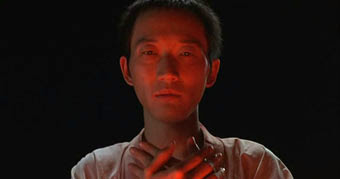Region 3 Hong Kong NTSC DVD (Joy Sales)
A meaningless barrage of screams, spooky noise and a muddle of images under the title sequence indicate where the film is going from the start.
Someone or other dies and curses the school (all these hangings keep reminding me of Lucio Fulci's City of the Living Dead, which kicks off with a priest sinning by suicide - now there's a horror film) with a curse that's even simpler and sillier than Friday the 13th - basically 'don't fall in love'. Guess what, the school's just gone co-ed. Four young men arrive in an all girl's school, with the teachers, and an angry ghost trying to keep them apart.
Shot on video, with very electronic special effects isn't the problem, though the ease of electronic editing is overused. My main complaint is really the lack of storytelling. Too often we see meaningless parade of exterior shots, spooky sounds, all while the story's going nowhere.
Volume is blasted up for no reason other than to scare, because the story isn't scary. I mean, it could have easily been called the Haunted Toilet, so much of the 'action' takes place in there!

Producer Andrew Lau (director of the Internal Affairs trilogy and Initial D - The Movie) has obviously the technology to make endless low budget movies - but he's short of scripts and scary horror isn't easy. Using the tested ploy of recruiting a cute cast, and designing a cool poster, plus slapping his name on the credits as a clincher. It worked on me, and I bought the DVD - but I won't be stung twice. If I'd known it was actually a film by the director of Devil Eye I'd have kept my HK dollars...
Granted there are a couple of inventive, but unscary ghost scenes, involving, surprise, a long haired ghost, and some laptop computer fx.
The English subs are OK, and there's an anamorphic picture, and DTS sound. But little within to actually entertain.












































